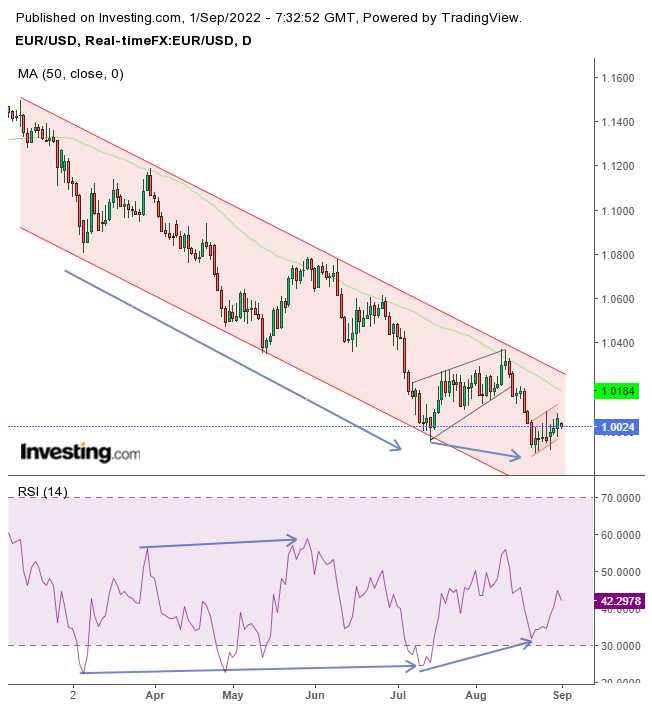Inflation in the euro area hit another record. Consumer prices jumped 9.1% annually.
The data sparked calls for a hefty interest rate hike. European Central Bank (ECB) Governing Council member Joachim Nagel advocated a "strong" increase.
However, the ECB is behind the US Federal Reserve in increasing rates. The Frankfurt, Germany based bank raised rates by 0.5% on July 21 to zero in its first hike in 11 years.
Investors have priced in a 125 basis point (bp) rise by October. The outlook is that the ECB's deposit rate will be 2.25% next year. That's just at the US Fed's lower limit.
Moreover, Fed members indicated US rates may be 3.75% - 4.00% by next year, almost double the ECB's, in an obvious dollar positive interest rate differential.
On August 17, I made a bearish call on the euro at $1.0171. The common currency has fallen 147 pips, or 1.44%, and I'm now giving the parameters for the next sell signal.
The price is developing a rising flag within a falling channel. However, beware of the MACD positive divergence. Therefore, it's essential to wait for the confirmation of the pattern completion according to your risk aversion.
Target
Measure the flag pole, the sharp drop before the flag's congestion, to gauge the next leg down following the downside breakout. Therefore, I predict the price will aim at 0.9500.
Rationale
After the exceptional drop, bears rushed to lock in profits. As sellers cover shorts, they reduce supply and increase demand, which is why the flag rises. However, the crowded nature of the range signifies that persistent selling is meeting the bearish demand. When whoever wanted is out, the price will break to the downside, as sellers seek more discerning buyers at lower prices. That would put the EUR/USD into a downward spiral of triggered shorts, covered longs, and new speculation.
Trading Strategies
Conservative traders should wait before shorting for the downside breakout, employing a 3%, 3-day filter to avoid a bear trap. Then, they should wait for a return move to retest the pattern's integrity.
Moderate traders would be content with a 2%, 2-day breakout, and a throwback for a better entry, if not for confirmation.
Aggressive traders could short after a 1%, 1-day breakout.
Trade Sample: Ahead Of A Breakout
Aggressive Short Position:
- Entry: 0.9900
- Stop-Loss: 1.0000
- Risk: 100 pips
- Target: 0.9500
- Reward: 400 pips
- Risk-Reward Ratio:
Author's Note: Ideally, you'd trade according to a strategy that incorporates your timing, budget, and temperament. This sample is to give you an idea of a basic plan. The model is not the analysis. Nor is the headline. That is in the article. I'm not in the fortune-telling business. I don't know what will happen. My opinion is based on the weight of the evidence, according to my interpretation. Happy trading (or not)!


